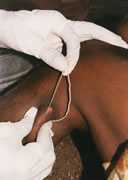WASH Away Neglected Tropical Diseases (NTDs) and the Guinea Worm Eradication Program (GWEP)

Extracting guinea worm from a person's leg. Photo courtesy of The Carter Center.
Since 2009, WASH Away NTD Activity staff have supported the Guinea Worm Eradication Program (GWEP). Activities include:
- Consulting on Guinea worm disease (GWD) to track cases, help with research, and evaluate disease eradication progress
- Distributing the monthly newsletter Guinea Worm Wrap-Up (produced by The Carter Center with CDC)
- Testing for GWD at CDC’s Division of Parasitic Diseases and Malaria
- Directing the World Health Organization (WHO) Collaborating Center for Research, Training, and Eradication of Dracunculiasis at CDC
What is Guinea Worm Disease?
GWD is a preventable parasitic disease that affects poor communities in remote parts of Africa that lack safe drinking water. The infection is spread to people who drink stagnant water containing tiny water fleas infected with Guinea worm larvae. Once swallowed, the water fleas are digested, releasing the Guinea worm larvae into the body. These larvae mature, mate, and about 10–14 months later, the pregnant female worm, now measuring up to 1 meter in length, creates a painful burning blister on the skin, often on the lower leg. To soothe the pain, a person infected with GWD might soak the blister in cool water. While the blister is in the water, the female worm comes out of the skin and deposits hundreds of thousands of larvae into the water. These larvae are then swallowed by the water fleas, and the cycle starts over again.
GWD can be prevented by simple interventions, most of which involve making water safer to drink. These interventions include:
- Providing wells and other safe sources of drinking water to communities affected by GWD
- Using cloth filters and pipe filters to strain the infected water fleas from drinking water
- Applying chemicals to surface water supplies to kill the water fleas
- Preventing infected people from entering water
GWD is one of the Neglected Tropical Diseases (NTDs), along with other WASH-related diseases like intestinal worms, schistosomiasis, and trachoma. Other NTDs include: African sleeping sickness, Chagas disease, leishmaniasis, lymphatic filariasis, and onchocerciasis (River Blindness). Since the beginning of the GWEP, the number of cases of GWD has dropped from 3.5 million cases in 20 countries in 1986 to 22 cases in four countries in 2015 (Chad, Ethiopia, Mali, and South Sudan). It is likely that GWD will become only the second disease ever to be eradicated from the world (the first disease was smallpox) and will be the first NTD to be eradicated.
- Page last reviewed: July 25, 2016
- Page last updated: July 25, 2016
- Content source:


 ShareCompartir
ShareCompartir